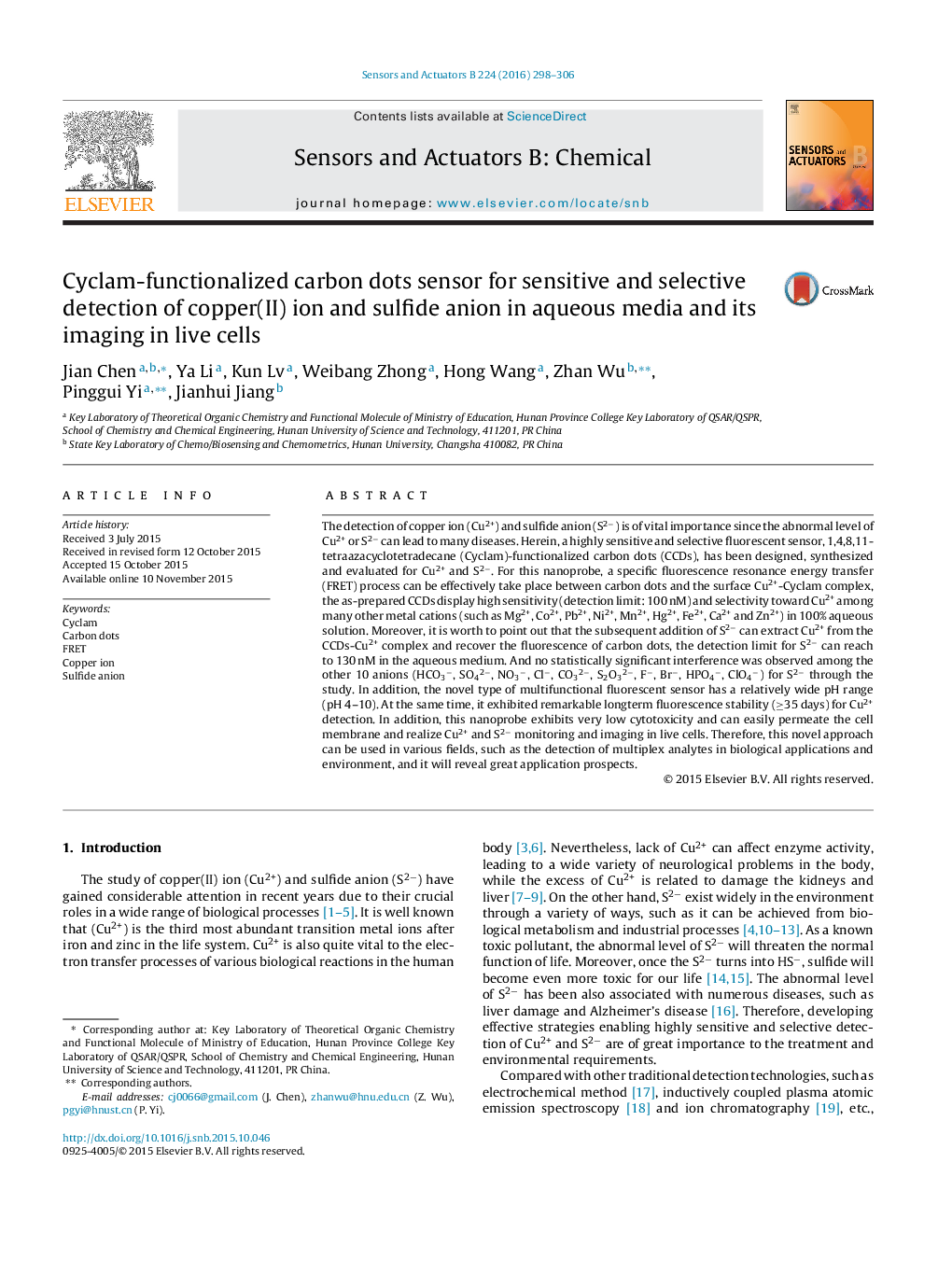| کد مقاله | کد نشریه | سال انتشار | مقاله انگلیسی | نسخه تمام متن |
|---|---|---|---|---|
| 750491 | 1462067 | 2016 | 9 صفحه PDF | دانلود رایگان |

• The CCDs sensor was prepared by surface modification of prepared carbon dots.
• The sensor can selectively sense Cu2+ and S2− in water.
• The detection limit of sensor is 100 nM for Cu2+ and 130 nM for S2−.
• The sensor has excellent longterm photostability and low cytotoxicity.
• The sensor can realize monitoring of Cu2+ and S2− in live cells.
The detection of copper ion (Cu2+) and sulfide anion (S2−) is of vital importance since the abnormal level of Cu2+ or S2− can lead to many diseases. Herein, a highly sensitive and selective fluorescent sensor, 1,4,8,11-tetraazacyclotetradecane (Cyclam)-functionalized carbon dots (CCDs), has been designed, synthesized and evaluated for Cu2+ and S2−. For this nanoprobe, a specific fluorescence resonance energy transfer (FRET) process can be effectively take place between carbon dots and the surface Cu2+-Cyclam complex, the as-prepared CCDs display high sensitivity (detection limit: 100 nM) and selectivity toward Cu2+ among many other metal cations (such as Mg2+, Co2+, Pb2+, Ni2+, Mn2+, Hg2+, Fe2+, Ca2+ and Zn2+) in 100% aqueous solution. Moreover, it is worth to point out that the subsequent addition of S2− can extract Cu2+ from the CCDs-Cu2+ complex and recover the fluorescence of carbon dots, the detection limit for S2− can reach to 130 nM in the aqueous medium. And no statistically significant interference was observed among the other 10 anions (HCO3−, SO42−, NO3−, Cl−, CO32−, S2O32−, F−, Br−, HPO4−, ClO4−) for S2− through the study. In addition, the novel type of multifunctional fluorescent sensor has a relatively wide pH range (pH 4–10). At the same time, it exhibited remarkable longterm fluorescence stability (≥35 days) for Cu2+ detection. In addition, this nanoprobe exhibits very low cytotoxicity and can easily permeate the cell membrane and realize Cu2+ and S2− monitoring and imaging in live cells. Therefore, this novel approach can be used in various fields, such as the detection of multiplex analytes in biological applications and environment, and it will reveal great application prospects.
Novel Cyclam-functionalized carbon dots for highly sensitive (detection limit: 100 nM for Cu2+ and 130 nM for S2−) and selective detection of Cu2+ and S2− in water were prepared by surface modification of prepared carbon dots. The prepared dual-ion sensor can be reversibly switched for several times by selective addition of adequate Cu2+ or S2−, and exhibited excellent longterm photostability for Cu2+ detection (≥35 days) in aqueous media. More importantly, the CCDs sensor also displayed low cytotoxicity and can be utilized to monitor Cu2+ and S2− level change in live cells.Figure optionsDownload as PowerPoint slide
Journal: Sensors and Actuators B: Chemical - Volume 224, 1 March 2016, Pages 298–306